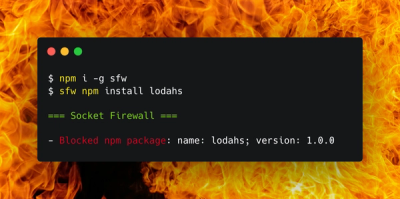
Security News
PodRocket Podcast: Inside the Recent npm Supply Chain Attacks
Socket CEO Feross Aboukhadijeh discusses the recent npm supply chain attacks on PodRocket, covering novel attack vectors and how developers can protect themselves.
@advanced-rest-client/api-authorization
Advanced tools
A custom element to render authorization editor rendering viuew based on AMF model.
A custom element that renders and manages authorization state in AMF powered application.
After applying the AMF model and security scheme for an operation the element decides which method to render, list of possible methods, manages state when the user change any of the values, and provides validation methods for the UI.
If authorization method operates on headers or query parameters this component dispatches corresponding change event so other component can update the sate.
More complex authorization schemes like OAuth 1or OAuth 2 first require obtaining access token. Once the token is obtained then validation state is updated and corresponding delivery method is used (header or query parameter).
This element support security description for both RAML and OAS.
Note, Digest authorization method is not supported at the time. If you are interested in this method, please, let us know.
npm install --save @advanced-rest-client/api-authorization
<html>
<head>
<script type="module">
import '@advanced-rest-client/api-authorization/api-authorization.js';
</script>
</head>
<body>
<api-authorization-method redirecturi="..."></api-authorization-method>
<script>
(async () => {
const model = await getAmfModel();
const security = getSecurity(model, '/endpoint', 'get');
const element = document.querySelector('api-authorization');
element.amf = model;
element.security = security;
element.onchange = (e) => {
if (e.target.validate()) {
const authList = e.target.serialize();
console.log(authList);
}
};
})();
</script>
</body>
</html>
import { LitElement, html } from 'lit-element';
import '@advanced-rest-client/api-authorization/api-authorization.js';
class SampleElement extends LitElement {
static get properties() {
return {
amfModel: { type: Array },
endpoint: { type: String },
method: { type: String },
};
}
get security() {
const { amfModel, endpoint, method } = this;
return this.readSecurityFor(amfModel, endpoint, method);
}
readSecurityFor(amf, endpoint, method) {
// implement me
}
_authChanged(e) {
if (e.target.validate()) {
const authList = e.target.serialize();
console.log(authList);
}
}
render() {
const { amfModel, security } = this;
return html`
<api-authorization
.amf="${amfModel}"
.security="${security}"
@change={this._authChanged}
></api-authorization-method>`;
}
}
customElements.define('sample-element', SampleElement);
First step is to pass the generated AMF model to the amf property. It is required to properly resolve internal model dependencies and to read keys in JSON+LD compact model.
Second step is to extract the correct security definition for an operation. It is added to a http://a.ml/vocabularies/apiContract#supportedOperation object. It should be an array of all supported by the operation methods.
An example script that applies the values can look like the following.
<api-authorization-method type="OAuth 2" id="auth"></api-authorization-method>
<script>
(async () => {
const model = await getAmfModelSomehow();
const security = readSecurityFor(model, '/endpoint', 'GET');
const method = document.getElementById('auth');
method.amf = model;
method.security = security;
})();
</script>
The getAmfModelSomehow() function can download pre-generated model or run AMF parser directly from RAML or OAS specification.
Then the readSecurityFor() function looks for security definition in /endpoint endpoint, inside GET method.
When ready the values are applied to the element.
The order of setting amf and security parameters doesn't matter as the data processing starts asynchronously.
A note on clearing settings property. When an undefined or any incompatible value is set to the settings property, the component renders nothing and sets aria-hidden attribute.
An API may define more than one authorization method to be applied to a request. This is possible with OAS defined APIs, RAML has no such concept. Because of that the settings getter (or serialize() function) returns an array of applied authorization settings.
Each object has type and valid properties. The type is one of the supported by the @advanced-rest-client/api-authorization-method values for type attribute. The valid property is a result of validating the element that provides the UI for the authorization method.
Additionally each object contains settings property that contains user entered values and configuration read from the API. The properties for this object depends on selected authorization method and it is a result of calling serialize() function on api-authorization-method.
The component does not propagate changes to the headers or query parameters.
This should be done before the request is being executed. For that call createAuthParams() method to generate a list of parameters to apply to the request object.
sendRequest() {
const authCmp = this.shadowRoot.querySelector('api-authorization');
const auth = authCmp.createAuthParams();
const request = {
method: 'GET',
url: 'https://api.domain.com/path?',
headers: '',
};
Object.keys(auth.headers).forEach((header) => request.headers += `${header}: ${auth.headers[header]}\n`);
Object.keys(auth.params).forEach((param) => request.url += `${param}=${auth.params[param]}&`);
}
Digest and NTLM authorization methods interacts with the request in a way that makes it impossible to apply the settings to the request before initializing the connection. It requires a series of requests and responses managed on the same connection. Because of that for this two methods the component produces authorization settings only. The hosting application must always check for current authorization settings and if either method is used then perform the authorization when connection is made.
OAuth 1 authorization is based on signing the request data: HTTP method and the URL. This may change after the authorization is set up.
Because of that the application that host this element must sign the request with the authorization header as described in this document. Use settings getter to get current settings.
The @advanced-rest-client/oauth-authorization component has signRequest(request, auth) method to sign a request for OAuth 1 protocol.
Example
const settings = node.serialize();
const oauth1 = settings.find((item) => item.type === 'oauth 1');
if (oauth1 && oauth1.valid) {
const oauth1auth = document.querySelector('oauth1-authorization');
oauth1auth.signRequest(request, oauth1.settings);
}
git clone https://github.com/advanced-rest-client/api-authorization
cd api-authorization
npm install
npm start
npm test
FAQs
Did you know?

Socket for GitHub automatically highlights issues in each pull request and monitors the health of all your open source dependencies. Discover the contents of your packages and block harmful activity before you install or update your dependencies.

Security News
Socket CEO Feross Aboukhadijeh discusses the recent npm supply chain attacks on PodRocket, covering novel attack vectors and how developers can protect themselves.

Security News
Maintainers back GitHub’s npm security overhaul but raise concerns about CI/CD workflows, enterprise support, and token management.

Product
Socket Firewall is a free tool that blocks malicious packages at install time, giving developers proactive protection against rising supply chain attacks.